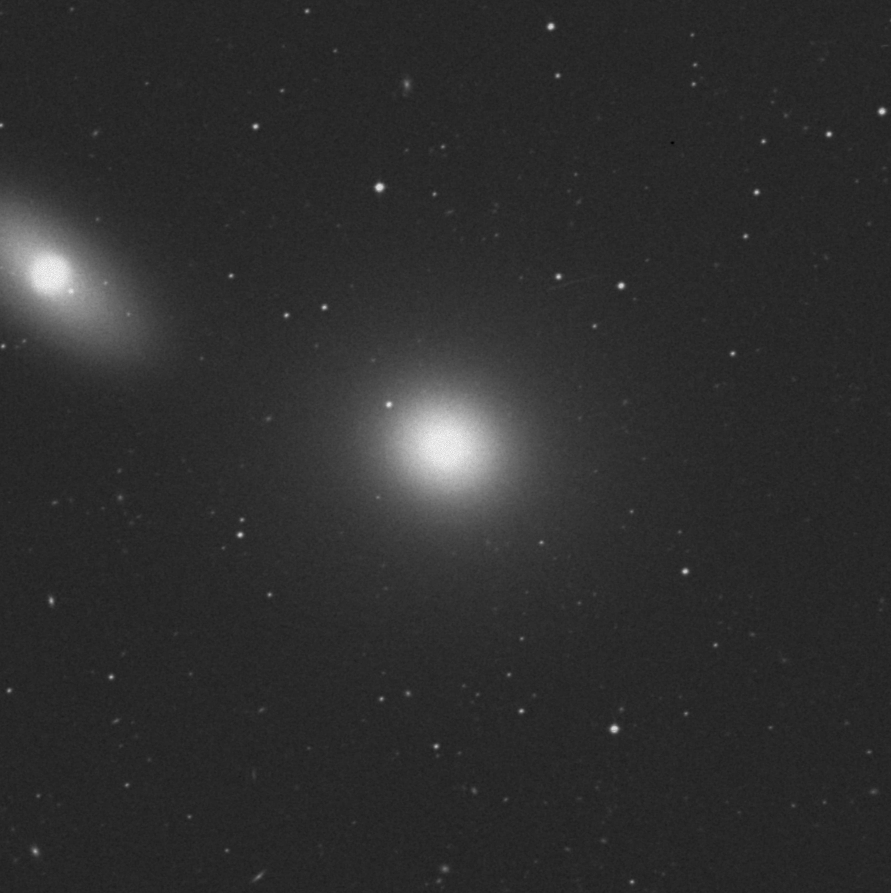Object Name: Messier 105
Alternative Designations: M105, NGC 3379
Object Type: E1 Elliptical Galaxy
Constellation: Leo
Right Ascension: 10 : 47.8 (h:m)
Declination: +12 : 35 (deg:m)
Distance: 38000 (kly)
Visual Brightness: 9.3 (mag)
Apparent Dimension: 2.0 (arc min)
Locating Messier 105: Begin your starhop for this great galaxy by identifying Alpha Leonis (Regulus), the brightest star in the backwards question mark that is the signature asterism of the constellation of Leo. Now, look east for the shallow triangle that marks the Lion’s hips. Your next marker is the southwestern star – Theta. Between them, on the belly of the Lion, you will see another faint, but unaided eye visible star. You’ll find Messier 105 just about two degrees (a fingerwidth) to the southeast of this star. If you cannot see this star, chances are you won’t be able to see this egg-shaped elliptical galaxy, either. From a clear, dark sky it can be spotted in larger binoculars and is fairly easy with a small telescope. While larger aperture will make the galaxy appear brighter and somewhat misty around the edges, elliptical galaxies do not produce much detail.
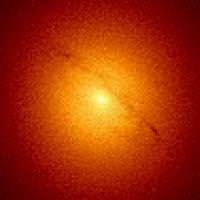 What You Are Looking At: Hanging out with the Leo 1 galaxy group some 38 million light years from our solar system, this ancient galaxy sports a core region that contains about 50 million times more mass than our own Sun. What is it? You got it. A black hole. “We combine Hubble Space Telescope spectroscopy and ground-based integral-field data from the SAURON and OASIS instruments to study the central black hole in the nearby elliptical galaxy NGC 3379. These models also probe the velocity distribution in the immediate vicinity of the black hole and reveal a nearly isotropic velocity distribution throughout the galaxy and down to the black hole sphere of influence RBH. The morphology of the nuclear gas disc suggests that it is not in the equatorial plane; however the core of NGC 3379 is nearly spherical. Inclined thin-disc models of the gas find a nominal black hole of mass (2.0 +/- 0.1) × 108Msolar (3sigma errors), but the model is a poor fit to the kinematics. The data are better fit by introducing a twist in the gas kinematics (with the black hole mass assumed to be 2.0 × 108Msolar), although the constraints on the nature and shape of this perturbation are insufficient for more detailed modelling.” says K.A. Shapiro (et al). “Given the apparent regularity of the gas disc appearance, the presence of such strong non-circular motion indicates that caution must be used when measuring black hole masses with gas dynamical methods alone.”
What You Are Looking At: Hanging out with the Leo 1 galaxy group some 38 million light years from our solar system, this ancient galaxy sports a core region that contains about 50 million times more mass than our own Sun. What is it? You got it. A black hole. “We combine Hubble Space Telescope spectroscopy and ground-based integral-field data from the SAURON and OASIS instruments to study the central black hole in the nearby elliptical galaxy NGC 3379. These models also probe the velocity distribution in the immediate vicinity of the black hole and reveal a nearly isotropic velocity distribution throughout the galaxy and down to the black hole sphere of influence RBH. The morphology of the nuclear gas disc suggests that it is not in the equatorial plane; however the core of NGC 3379 is nearly spherical. Inclined thin-disc models of the gas find a nominal black hole of mass (2.0 +/- 0.1) × 108Msolar (3sigma errors), but the model is a poor fit to the kinematics. The data are better fit by introducing a twist in the gas kinematics (with the black hole mass assumed to be 2.0 × 108Msolar), although the constraints on the nature and shape of this perturbation are insufficient for more detailed modelling.” says K.A. Shapiro (et al). “Given the apparent regularity of the gas disc appearance, the presence of such strong non-circular motion indicates that caution must be used when measuring black hole masses with gas dynamical methods alone.”
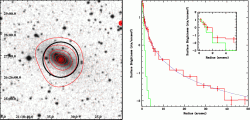 And it is the gas (or lack thereof) that keeps astronomers going back to study M105. Is it possible that there is not only one – but two – black holes within its core? “Such a small amount of gas can be supplied by stellar mass loss in only 107 yr. Thus, the gas must be accreting into the central supermassive black hole at a very low radiative efficiency as in the ADAF or RIAF models, or it is being expelled in a galactic wind driven by the same AGN feedback mechanism as that observed in cluster cooling flows. If the gas is being expelled in an AGN-driven wind, then the ratio of mechanical to radio power of the AGN must be 104, which is comparable to that measured in cluster cooling flows that have recently been perturbed by radio outbursts. Only 8% of the detected point sources are coincident with globular cluster positions, which is significantly less than that found among other elliptical galaxies observed by Chandra. The low specific frequency of globular clusters and the small fraction of X-ray point sources associated with globular clusters in NGC 3379 is more similar to the properties of lenticular galaxies rather than elliptical galaxies.” says Laurence P. David, (et al).
And it is the gas (or lack thereof) that keeps astronomers going back to study M105. Is it possible that there is not only one – but two – black holes within its core? “Such a small amount of gas can be supplied by stellar mass loss in only 107 yr. Thus, the gas must be accreting into the central supermassive black hole at a very low radiative efficiency as in the ADAF or RIAF models, or it is being expelled in a galactic wind driven by the same AGN feedback mechanism as that observed in cluster cooling flows. If the gas is being expelled in an AGN-driven wind, then the ratio of mechanical to radio power of the AGN must be 104, which is comparable to that measured in cluster cooling flows that have recently been perturbed by radio outbursts. Only 8% of the detected point sources are coincident with globular cluster positions, which is significantly less than that found among other elliptical galaxies observed by Chandra. The low specific frequency of globular clusters and the small fraction of X-ray point sources associated with globular clusters in NGC 3379 is more similar to the properties of lenticular galaxies rather than elliptical galaxies.” says Laurence P. David, (et al).
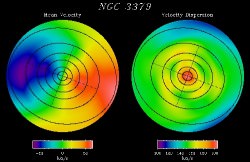 “The brightest point source in NGC 3379 is located 360 pc from the central AGN with a peak luminosity of 3.5 × 1039 ergs s-1, which places it in the class of ultraluminous X-ray point sources (ULXs). Analysis of an archival ROSAT HRI observation of NGC 3379 shows that this source was at a comparable luminosity 5 yr prior to the Chandra observation. The spectrum of the ULX is well described by a power-law model with ? = 1.6 ± 0.1 and galactic absorption, similar to other ULXs observed by Chandra and XMM-Newton and to the low-hard state observed in Galactic black hole binaries. During the Chandra observation, the source intensity smoothly varies by a factor of 2 with the suggestion of an 8-10 hr period. No changes in hardness ratio are detected as the intensity of the source varies. While periodic behavior has recently been detected in several ULXs, all of these reside within spiral galaxies. The ULX in NGC 3379 is the only known ULX in an elliptical galaxy with a smoothly varying light curve suggestive of an eclipsing binary system.”
“The brightest point source in NGC 3379 is located 360 pc from the central AGN with a peak luminosity of 3.5 × 1039 ergs s-1, which places it in the class of ultraluminous X-ray point sources (ULXs). Analysis of an archival ROSAT HRI observation of NGC 3379 shows that this source was at a comparable luminosity 5 yr prior to the Chandra observation. The spectrum of the ULX is well described by a power-law model with ? = 1.6 ± 0.1 and galactic absorption, similar to other ULXs observed by Chandra and XMM-Newton and to the low-hard state observed in Galactic black hole binaries. During the Chandra observation, the source intensity smoothly varies by a factor of 2 with the suggestion of an 8-10 hr period. No changes in hardness ratio are detected as the intensity of the source varies. While periodic behavior has recently been detected in several ULXs, all of these reside within spiral galaxies. The ULX in NGC 3379 is the only known ULX in an elliptical galaxy with a smoothly varying light curve suggestive of an eclipsing binary system.”
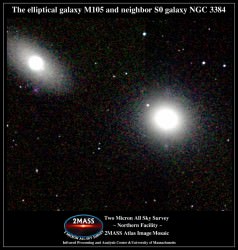 Is this structure a probable result of interaction with neighboring galaxies in the group? “The central regions of the three brightest members of the Leo I galaxy group—NGC 3368, NGC 3379, and NGC 3384—are investigated by means of two-dimensional spectroscopy. In all three galaxies we have found separate circumnuclear stellar and gaseous subsystems—more probably, disks—whose spatial orientations and spins are connected to the spatial orientation of the supergiant intergalactic H i ring reported previously by Schneider et al. and Schneider. In NGC 3368 the global gaseous disk seems also to be inclined to the symmetry plane of the stellar body, being probably of external origin.” says O. K. Sil’chenko (et al). “Although the rather young mean stellar age and spatial orientations of the circumnuclear disks in NGC 3379, NGC 3384, and NGC 3368 could imply their recent formation from material of the intergalactic H i cloud, the timescale of these secondary formation events, on the order of 3 Gyr, does not support the collision scenario of Rood & Williams but is rather in line with the ideas of Schneider regarding tidal interactions of the galaxies with the H i cloud on timescales of the intergroup orbital motions.”
Is this structure a probable result of interaction with neighboring galaxies in the group? “The central regions of the three brightest members of the Leo I galaxy group—NGC 3368, NGC 3379, and NGC 3384—are investigated by means of two-dimensional spectroscopy. In all three galaxies we have found separate circumnuclear stellar and gaseous subsystems—more probably, disks—whose spatial orientations and spins are connected to the spatial orientation of the supergiant intergalactic H i ring reported previously by Schneider et al. and Schneider. In NGC 3368 the global gaseous disk seems also to be inclined to the symmetry plane of the stellar body, being probably of external origin.” says O. K. Sil’chenko (et al). “Although the rather young mean stellar age and spatial orientations of the circumnuclear disks in NGC 3379, NGC 3384, and NGC 3368 could imply their recent formation from material of the intergalactic H i cloud, the timescale of these secondary formation events, on the order of 3 Gyr, does not support the collision scenario of Rood & Williams but is rather in line with the ideas of Schneider regarding tidal interactions of the galaxies with the H i cloud on timescales of the intergroup orbital motions.”
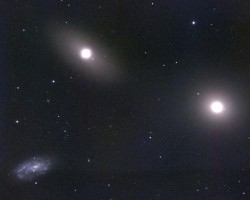 History: M105 was discovered by Pierre Mechain on March 24, 1781, actually 3 days before catalog number M101 was discovered. Although most claim there wasn’t any reason that it wasn’t included in Charles Messier’s published list, it was a bad time for Messier who had just lost his wife and newborn son and it would be easy to make a mistake or overlook an observation. Mechain described this object in his letter of May 6, 1783: “Mr. Messier mentions there on page 264 and 265 two nebulous stars, which I have discovered in the Lion [Leo; M95 and M96]. I find nothing to correct for the given positions which I have determined by comparison of their situation with respect to Regulus. There is, however, a third one, somewhat more northerly, which is even more vivid [brighter] than the two preceding ones [M95 and M96]. I discovered this one on March 24, 1781, 4 or 5 days after I had found the other two. On April 10, I compared its situation with Gamma Leonis from which followed its right ascension 159d 3′ 45″ and its northern declination of 13d 43′ 58”.
History: M105 was discovered by Pierre Mechain on March 24, 1781, actually 3 days before catalog number M101 was discovered. Although most claim there wasn’t any reason that it wasn’t included in Charles Messier’s published list, it was a bad time for Messier who had just lost his wife and newborn son and it would be easy to make a mistake or overlook an observation. Mechain described this object in his letter of May 6, 1783: “Mr. Messier mentions there on page 264 and 265 two nebulous stars, which I have discovered in the Lion [Leo; M95 and M96]. I find nothing to correct for the given positions which I have determined by comparison of their situation with respect to Regulus. There is, however, a third one, somewhat more northerly, which is even more vivid [brighter] than the two preceding ones [M95 and M96]. I discovered this one on March 24, 1781, 4 or 5 days after I had found the other two. On April 10, I compared its situation with Gamma Leonis from which followed its right ascension 159d 3′ 45″ and its northern declination of 13d 43′ 58”.
Messier 105 would be later recovered by Sir William Herschel who believed he was looking at multiple nebulae: “If it was supposed that double nebulae at some distance from each other would frequently be seen, it will now on the contrary be admitted that an expectation of finding a great number of attracting centers in a nebulosity of no great extent is not so probable; and accordingly observation has shewn that greater combinations of nebular than those of the foregoing article.” His son, John, would also observe M105 and give it a catalog designation as well.
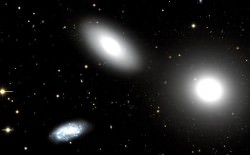 However, it was Admiral Smyth who described it eloquently; “A pair of bright-class nebulae, sp [south preceding, SW] and nf [north following, NE] of each other, on the Lion’s belly, discovered by WH [William Herschel] in March, 1783, and No. 758 [NGC 3384] in his son’s Catalogue; while at a small distance to the nf [north following, NE] is a neat but minute double star. These are two of the three nebulae described by both Herschels [M105 and NGC 3384]; but the third [NGC 3389] I cannot distinguish, unless it be a glow in the sf [south following, SE], in a vertical line with two small stars. We now approach a region where these mysterious luminous masses are scattered over the vast concavity of the heavens, in truly boundless profusion; and in them, all true Herschelians must view mighty laboratories of the Universe, in which are contained the principles of future systems of suns, planets and satellites! The objects here treated of, are among the nebulae included within a round patch of about 2 deg or 3 deg in diameter, in the apparently starless space of the Lion’s loins. Now the observer unprovided with an equatorial instrument – and unfortunately many of Urania’s most zealous followers are in that predicament – may wish to fish it up. If his telescope be of capacity for grasping sufficient light, the field may be found, under a moderate power, south of the line which joins Regulus and Theta Leonis about 10 deg east of, and nearly on the parallel with, the former.”
However, it was Admiral Smyth who described it eloquently; “A pair of bright-class nebulae, sp [south preceding, SW] and nf [north following, NE] of each other, on the Lion’s belly, discovered by WH [William Herschel] in March, 1783, and No. 758 [NGC 3384] in his son’s Catalogue; while at a small distance to the nf [north following, NE] is a neat but minute double star. These are two of the three nebulae described by both Herschels [M105 and NGC 3384]; but the third [NGC 3389] I cannot distinguish, unless it be a glow in the sf [south following, SE], in a vertical line with two small stars. We now approach a region where these mysterious luminous masses are scattered over the vast concavity of the heavens, in truly boundless profusion; and in them, all true Herschelians must view mighty laboratories of the Universe, in which are contained the principles of future systems of suns, planets and satellites! The objects here treated of, are among the nebulae included within a round patch of about 2 deg or 3 deg in diameter, in the apparently starless space of the Lion’s loins. Now the observer unprovided with an equatorial instrument – and unfortunately many of Urania’s most zealous followers are in that predicament – may wish to fish it up. If his telescope be of capacity for grasping sufficient light, the field may be found, under a moderate power, south of the line which joins Regulus and Theta Leonis about 10 deg east of, and nearly on the parallel with, the former.”
Enjoy your own look into these “mighty laboratories of the universe”!
Top M105 image credit, Palomar Observatory courtesy of Caltech, M105 Black Hole courtesy of Karl Gebhardt (University of Michigan), Tod Lauer (NOAO), and NASA, M105 rotation courtesy of Ohio State University, M105 2MASS image, M105 group image by Isaac Newton Telescope and M105 image courtesy of NOAO/AURA/NSF.

